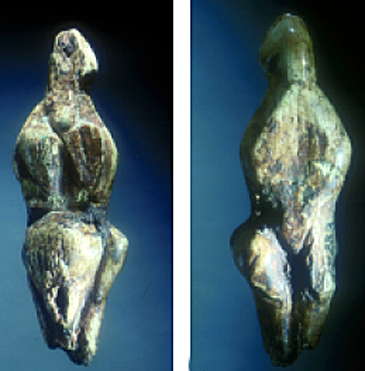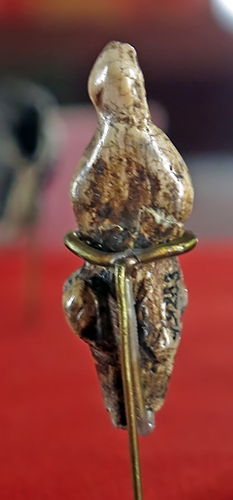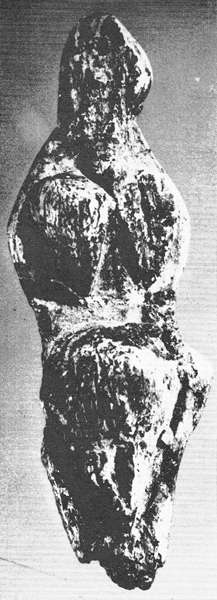Back to Don's Maps
Back to Venus figures from the Stone Age
Back to the Grimaldi - Balzi Rossi Venus figures
The Venus with Goitre
The Woman with Goitre from Grimaldi has only one torso and one head, but underneath, she has two pubic triangles and two opposite legs. The figure is made of ivory, (the material had previously been misidentified as antler) and is 45 mm long. The face is ovoid, but there are no facial features shown, and no arms. The breasts are conical with the tips pointed down. There is a goitre at the neck. The belly is prominent, the hips are wide, and the buttocks flattened. The vulva is open, with a gynecological perspective. The legs are broken off below the vulva. The 'Woman with Goitre' was found between 3 and 4.2 m deep in a layer which is probably the final Epigravettian. A radiocarbon date of 14 110 ±150 BP (Gif-sur-Yvette A95074) may be allotted (with caution) to this layer. It may be that this figure is the same age.

The two faces of the Woman with goitre, Grimaldi. She has only one torso and one head, but underneath, she has two pubic triangles and two opposite legs.
Photo: R. White
Source: White (2002)

The Woman with Goitre from Grimaldi, rear view.
Photo: Don Hitchcock 2015
Source: Original, la salle Piette, Musée d'Archeologie Nationale et Domaine, St-Germain-en-Laye
Catalog: MAN49283

The Woman with Goitre from Grimaldi, frontal view.
Photo: Don Hitchcock 2015
Source: Original, la salle Piette, Musée d'Archeologie Nationale et Domaine, St-Germain-en-Laye
The figure is made of ivory, and is 45 mm long. The face is ovoid, but there are no facial features shown, and no arms. The breasts are conical with the tips pointed down. There is a goitre at the neck. The belly is prominent, the hips are wide, and the buttocks flattened. The vulva is open, with a gynecological perspective. The legs are broken off below the vulva.
The 'Woman with Goitre' was found between 3 and 4.2 m deep in a layer which is probably the final Epigravettian. A radiocarbon date of 14 110 ±150 BP (Gif-sur-Yvette A95074) may be allotted (with caution) to this layer. It may be that this figure is the same age.>
Text above adapted from White et Bisson (1998)

Venus with goitre.
The woman with goitre is a bone sculpture collected by Jullien, in 1884 - 1885 in the Barma Grande, acquired by Piette and given to Saint-Germain (MAN, No. 49283). It measures 45 mm. height, 14 mm. maximum width and 8 mm maximum thickness at the pelvis.
The piece is badly damaged, with flakes broken off the head, the left breast as well as the hip and right buttock. The base of the breast has also been damaged recently, probably during the course of excavation, and it is likely that the figurine was broken and glued. Where it is not damaged, for example on the posterior surface of the head and chest, the material is highly polished and even seems worn.
The head is sub-rhombic, but chips broken off the head do not permit determination of whether the facial features were represented.
The neck is reasonably well shown, and carries on its front face, a small nodule, located above the breasts, which Piette considered as the representation of goitre, a deformity he put down to the fact that these people drank water from melting snow (which would not contain iodine, the lack of which is the major cause of goitre - Don) - hence the name of the figure.
An equally valid hypothesis was proposed by Luquet who thinks that this relief represents a pendant, a part of a necklace.
The breasts, like the mass of the stomach, have the shape of a triangle in relief, with its tip pointing downwards and whose opposite side is convex. The breasts and belly are relatively large.
The abdomen, the outlines of which closely recalls that of the vulvas of the Aurignacian, presents at its lower tip, the slot of the vulva. The mass of the abdomen, very prominent, carries a series of thin irregular vertical lines.
The arms are not represented. As for the the legs, they could end in a point, but are broken at the level of the knees. The thighs, relatively thin, are separated from the mass of the stomach and the vulva by a groove.
The torso is a bit thick, like the yellow soapstone statuette. The back is slightly concave, the kidneys are marked by a groove in the form of an angle opening upward, which extends down through a large incision, separating the rather large buttocks - one of them, as previously stated, is destroyed - the large and protruding buttocks give the model a character quite clearly steatopygous. On the back, the boundary between the buttocks and thighs is marked on each leg by an oblique groove.
Photo: Delporte (1993)
Text above translated from: Delporte (1993)
References
- Bisson M, Bolduc P., 1994: "Previously Undescribed Figurines From the Grimaldi Caves." Current Anthropology, 35(4) (Aug.-Oct. 1994) : 458-468.
- Cohen C., 2003: La femme des origines. Images de la femme dans la préhistoire occidentale,, Paris, Belin-Herscher, 2003, 191 pages.
- Delporte H., 1993: L’image de la femme dans l’art préhistorique, Éd. Picard (1993)
- Jennett K., 2008: "Female Figurines of the Upper Paleolithic" (2008), University Honors Program Paper 74. http://ecommons.txstate.edu/honorprog/74
- White, R., Bisson M., 1998: Imagerie féminine du Paléolithique : l'apport des nouvelles statuettes de Grimaldi, Gallia préhistoire. Tome 40, 1998. pp. 95-132.